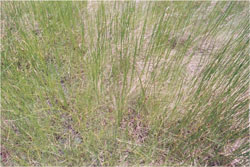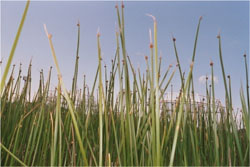
 |
|---|
Salt Marsh Site |
 |
 |
|---|---|
| Spartina Patens | Scirpus Olneyi |
Abstract
Photorespiration is a possible cause of the inhibition of respiration in the light (RL) demonstrated by the Kok effect. Products of photorespiration could potentially deactivate a key respiratory enzyme – the pyruvate dehydrogenase complex (PDC). By comparing the results of Kok method light response curves under conditions where photorespiration is and is not likely to occur, this study attempts to isolate the role of photorespiration in the photoinhibition of RL. Comparative measurements were taken between a C3 and a C4 species and at ambient (385 ppm) and elevated (800 ppm) CO2 concentrations. 10 samples were measured of each of two salt marsh grass species; Scirpus olneyi, a C3 plant; and Spartina patens, a C4 plant. Statistical analyses indicate that the mean RL/RD ratio was significantly lower for the C3 plants at ambient CO2 concentrations. The Kok effect was not present (or was extremely reduced) in the C3 species at an elevated CO2 concentration and the C4 species at either CO2 level. This study presents evidence in support of the hypothesis that photorespiration indirectly causes the photoinhibition of respiration.
| Research Site - Smithsonian Environmental Resarch Center, Chesapeake Bay, MD |
|---|
Go to Science Research Projects.
Go to Learning Objectives of Research Project.
Return to E&ESJ home page.
Last updated: 8 January 2001, KAK.